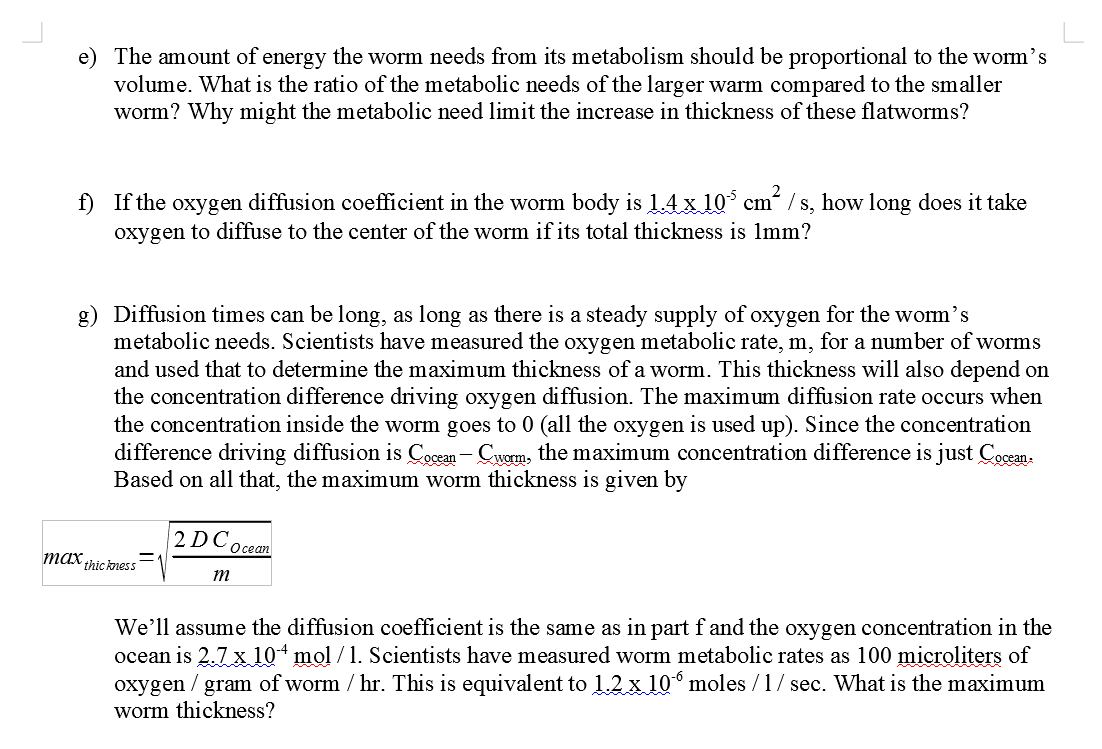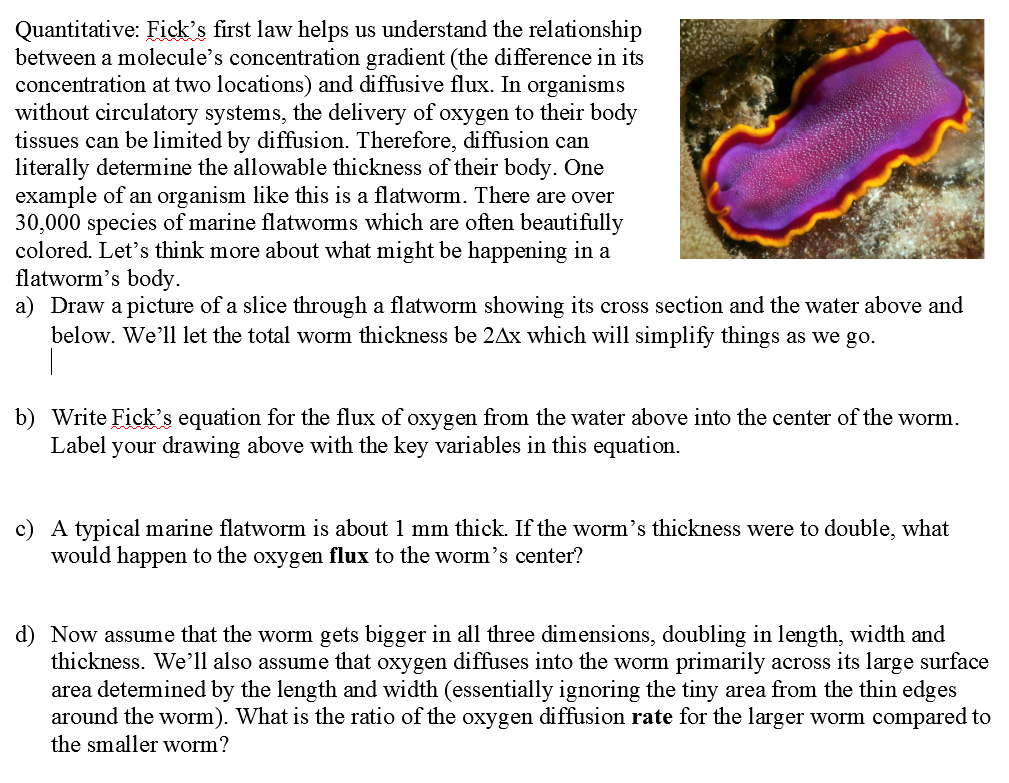e) The amount of energy the worm needs from its metabolism should be proportional to the worm's volume. What is the ratio of the metabolic needs of the larger warm compared to the smaller worm? Why might the metabolic need limit the increase in thickness of these flatworms?
e) The amount of energy the worm needs from its metabolism should be proportional to the worm's volume. What is the ratio of the metabolic needs of the larger warm compared to the smaller worm? Why might the metabolic need limit the increase in thickness of these flatworms?
Biology (MindTap Course List)
11th Edition
ISBN:9781337392938
Author:Eldra Solomon, Charles Martin, Diana W. Martin, Linda R. Berg
Publisher:Eldra Solomon, Charles Martin, Diana W. Martin, Linda R. Berg
Chapter46: Gas Exchange
Section: Chapter Questions
Problem 7TYU: Test Your Understanding 7. According to Ficks law of diffusion, a gas will diffuse faster if the (a)...
Related questions
Question

Transcribed Image Text:e) The amount of energy the worm needs from its metabolism should be proportional to the worm's
volume. What is the ratio of the metabolic needs of the larger warm compared to the smaller
worm? Why might the metabolic need limit the increase in thickness of these flatworms?
f) If the oxygen diffusion coefficient in the worm body is 1.4 x 105 cm² /s, how long does it take
oxygen to diffuse to the center of the worm if its total thickness is 1mm?
g) Diffusion times can be long, as long as there is a steady supply of oxygen for the worm’s
metabolic needs. Scientists have measured the oxygen metabolic rate, m, for a number of worms
and used that to determine the maximum thickness of a worm. This thickness will also depend on
the concentration difference driving oxygen diffusion. The maximum diffusion rate occurs when
the concentration inside the worm goes to 0 (all the oxygen is used up). Since the concentration
difference driving diffusion is Cocean - Cworm, the maximum concentration difference is just Cocean.
Based on all that, the maximum worm thickness is given by
max thickness
2DC,
m
Ocean
We'll assume the diffusion coefficient is the same as in part f and the oxygen concentration in the
ocean is 2.7 x 104 mol /1. Scientists have measured worm metabolic rates as 100 microliters of
oxygen / gram of worm / hr. This is equivalent to 1.2 x 106 moles /1/ sec. What is the maximum
worm thickness?

Transcribed Image Text:Quantitative: Fick's first law helps us understand the relationship
between a molecule's concentration gradient (the difference in its
concentration at two locations) and diffusive flux. In organisms
without circulatory systems, the delivery of oxygen to their body
tissues can be limited by diffusion. Therefore, diffusion can
literally determine the allowable thickness of their body. One
example of an organism like this is a flatworm. There are over
30,000 species of marine flatworms which are often beautifully
colored. Let's think more about what might be happening in a
flatworm's body.
a) Draw a picture of a slice through a flatworm showing its cross section and the water above and
below. We'll let the total worm thickness be 2Ax which will simplify things as we go.
b) Write Fick's equation for the flux of oxygen from the water above into the center of the worm.
Label your drawing above with the key variables in this equation.
c) A typical marine flatworm is about 1 mm thick. If the worm's thickness were to double, what
would happen to the oxygen flux to the worm's center?
d) Now assume that the worm gets bigger in all three dimensions, doubling in length, width and
thickness. We'll also assume that oxygen diffuses into the worm primarily across its large surface
area determined by the length and width (essentially ignoring the tiny area from the thin edges
around the worm). What is the ratio of the oxygen diffusion rate for the larger worm compared to
the smaller worm?
Expert Solution
This question has been solved!
Explore an expertly crafted, step-by-step solution for a thorough understanding of key concepts.
Step by step
Solved in 2 steps

Knowledge Booster
Learn more about
Need a deep-dive on the concept behind this application? Look no further. Learn more about this topic, biology and related others by exploring similar questions and additional content below.Recommended textbooks for you

Biology (MindTap Course List)
Biology
ISBN:
9781337392938
Author:
Eldra Solomon, Charles Martin, Diana W. Martin, Linda R. Berg
Publisher:
Cengage Learning

Anatomy & Physiology
Biology
ISBN:
9781938168130
Author:
Kelly A. Young, James A. Wise, Peter DeSaix, Dean H. Kruse, Brandon Poe, Eddie Johnson, Jody E. Johnson, Oksana Korol, J. Gordon Betts, Mark Womble
Publisher:
OpenStax College

Biology (MindTap Course List)
Biology
ISBN:
9781337392938
Author:
Eldra Solomon, Charles Martin, Diana W. Martin, Linda R. Berg
Publisher:
Cengage Learning

Anatomy & Physiology
Biology
ISBN:
9781938168130
Author:
Kelly A. Young, James A. Wise, Peter DeSaix, Dean H. Kruse, Brandon Poe, Eddie Johnson, Jody E. Johnson, Oksana Korol, J. Gordon Betts, Mark Womble
Publisher:
OpenStax College